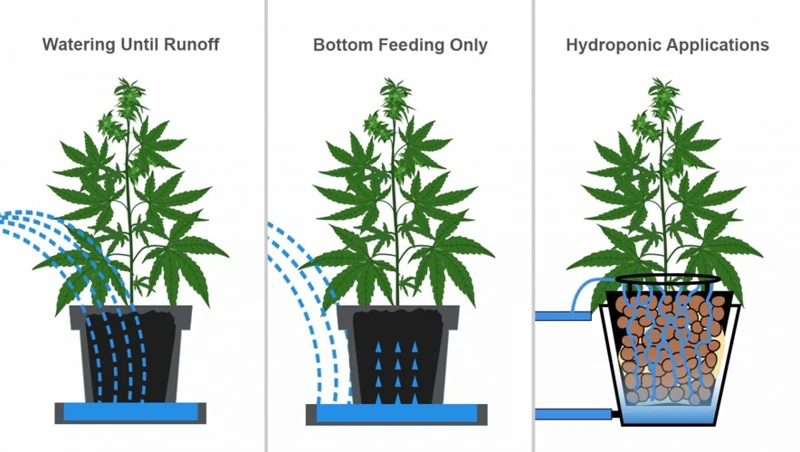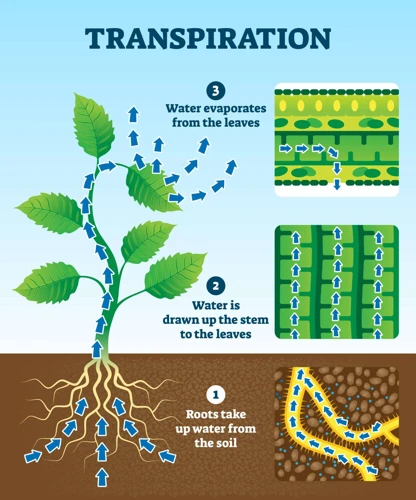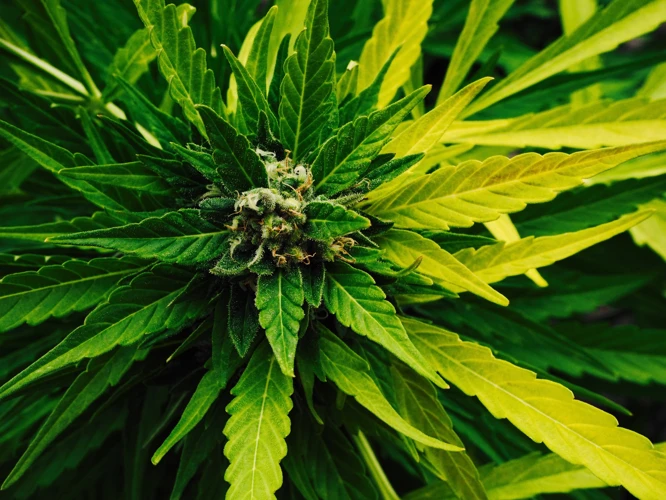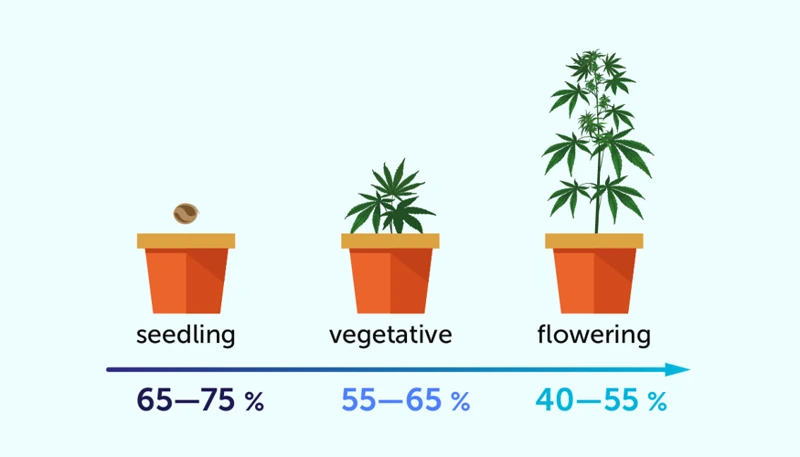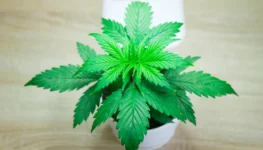
Optimal Watering Techniques for Cannabis Plants in Different Humidity Levels
Growing cannabis can be an exciting and fulfilling experience, but it’s not without its challenges. One of the most critical factors to consider when growing cannabis is getting the watering right. While it may seem like a simple task, there are many factors to take into account, including the humidity level. Understanding how humidity affects watering needs in cannabis plants can be perplexing, especially for novice growers. However, with the right knowledge and techniques, growers can ensure their plants receive optimal amounts of water, providing them with the best chance of thriving. In this article, we’ll take a comprehensive look at the impact of humidity on watering needs in cannabis plants and provide tips and techniques for ensuring your plants stay hydrated and healthy.
Understanding Watering Needs
Contents
As a cannabis grower, understanding the watering needs of your plants is crucial for their overall health and development. There are various factors that can affect how much water your cannabis plants require, such as the type of soil, the size of the container, and the stage of growth. It’s important to measure the watering needs properly to avoid overwatering or underwatering your plants. Let’s explore these factors in more detail and analyze how they influence the watering demands of your cannabis plants. Additionally, we’ll examine the risks of underwatering and overwatering and provide solutions for different humidity levels. Lastly, we’ll share some tips for watering your cannabis plants to ensure they receive the optimal amount of water they need.
Factors Affecting Watering Needs
Several factors influence the watering needs of cannabis plants, including:
| Factor | Description |
| Humidity | The amount of moisture in the air affects the rate at which plants transpire, which impacts their watering needs. |
| Plant size and stage | The size of the plant and the growth stage it is in will determine how much water it needs. |
| Growing medium | The type of soil or other growing medium, as well as its moisture retention capacity, also affects watering needs. |
| Temperature | Temperature affects the rate at which plants transpire and the amount of water evaporation from the soil surface. |
| Light intensity | The intensity of light affects the rate of photosynthesis, which impacts the amount of water the plant needs. |
| Air circulation | Good air circulation promotes transpiration, which helps prevent overwatering and root rot by drying out the soil faster. |
Understanding these factors and how they interact can help growers better determine when and how much to water their cannabis plants. It’s important to remember that the specific watering needs of a plant will vary based on these factors and the unique conditions of the growing environment. If not properly managed, the plants can experience underwatering or overwatering with different signs and symptoms.
Measuring Watering Needs
One of the most crucial aspects of cannabis plant care is understanding their watering needs. Many factors can affect how often plants should be watered, including humidity levels, temperature, the size of the plant, and the type of soil. Measuring the watering needs of cannabis plants is essential to maintain optimal growth and prevent over or underwatering.
One method to measure watering needs is to pay attention to the soil moisture level. Understanding how much moisture is present in the soil is vital to ensure that cannabis plants receive the right amount of water. One way to check the soil moisture level is to insert a finger into the soil about an inch or two deep. If the soil feels dry, it is time to water the plants. On the other hand, if the soil feels damp, it is better to wait before watering.
Another way to determine watering needs is to use a soil moisture meter. This tool measures the soil’s moisture content and displays the results on a scale. With a soil moisture meter, growers can quickly determine if their cannabis plants need watering.
Additionally, understanding the weight of the container can also help to determine watering needs. When the soil is dry, the container will feel significantly lighter compared to when the soil is moist. By weighing the container, growers can get a better sense of when it is time to water their cannabis plants.
| Methods for Measuring Watering Needs | Advantages | Disadvantages |
|---|---|---|
| Checking soil moisture level by inserting a finger | Simple and requires no additional tools | May be inaccurate depending on the depth of the inserted finger and the type of soil |
| Using a soil moisture meter | Accurate and easy to use | May require additional cost to purchase the tool |
| Weighing the container | Provides a quick sense of the soil moisture level | May be inaccurate if the weight of the container varies or if the grower is inexperienced in using this method |
Using these methods, growers can ensure that they are providing their cannabis plants with optimal and appropriate hydration. Keeping them healthy and thriving throughout their growth cycle.
Effects of High Humidity
As a cannabis grower, humidity is one environmental factor you cannot overlook. High humidity can lead to a variety of problems for your cannabis plants, affecting their overall health and productivity. It’s important to understand the potential risks of high humidity and how it impacts your watering needs. Let’s take a closer look at the effects of high humidity on your cannabis plants and what you can do to prevent overwatering.
Overwatering Risks
Overwatering is a common mistake made by novice growers, and it can have detrimental effects on the health and growth of cannabis plants. Here are some of the risks associated with overwatering:
- Root rot: When cannabis plants are overwatered, the soil becomes waterlogged and the roots suffocate. This can lead to root rot, which is a fungal disease that can ultimately kill the plant.
- Nutrient deficiencies: Overwatering can wash away important nutrients from the soil, leaving the plant unable to absorb the necessary minerals for healthy growth.
- Stunted growth: Overwatering can slow down the growth of cannabis plants, as the saturated soil makes it difficult for the roots to efficiently take up water and nutrients.
- Pest infestations: Moist soil provides the perfect breeding ground for pests and pathogens that can damage or kill cannabis plants. Overwatering can also weaken the plant’s immune system, making it more susceptible to pests and diseases.
To minimize the risks of overwatering, it’s important to ensure that the soil is allowed to dry out partially between watering. The frequency of watering will depend on the humidity level in the environment and the size of the plant, as larger plants will require more water.
Watering Frequency
One of the key factors in determining the watering needs of cannabis plants is frequency. The frequency of watering largely depends on the humidity levels in the environment. When the humidity is high, the plants tend to require less frequent watering. Conversely, when the humidity is low, the plants require more frequent watering.
Factors Affecting Watering Frequency
The frequency of watering is not solely dependent on humidity levels. Other factors that affect watering frequency include the size of the plants, the size of the containers, and the type of soil used. Plants that are grown in larger containers or in soil that has good water retention capacity may require less frequent watering. On the other hand, plants that are grown in smaller containers or in soil with poor water retention may require more frequent watering.
Measuring the Watering Needs
One way to determine the watering needs of cannabis plants is to check the soil moisture level. A good way to do this is to stick a finger into the soil up to the second knuckle. If the soil feels dry to the touch, it’s time to water the plants. Another way to check for watering needs is to lift up the container. If it feels light, it’s an indication that the plant requires watering.
Optimal Watering Techniques for High Humidity Levels
In environments with high humidity levels, it’s important to water cannabis plants less frequently. Overwatering can lead to root rot, stunted growth, and other negative effects. It’s best to wait until the soil has partially dried out before watering the plants. Additionally, it’s important to avoid watering during the evening when the temperatures are cooler and the humidity is higher.
Optimal Watering Techniques for Low Humidity Levels
In environments with low humidity levels, cannabis plants require more frequent watering. It’s important to keep the soil moist, but not waterlogged. Overwatering can lead to nutrient deficiencies and other negative effects. One way to maintain the proper moisture levels in low humidity environments is to use a humidity dome or other humidity-enhancing device.
Tips for Watering Cannabis Plants
Checking the soil moisture level is a crucial step in determining the watering needs of cannabis plants. It’s important to water the plants at the right time of day and to choose the right watering method. Overhead watering can lead to leaf mold and other fungal diseases, so it’s best to water the plants at the base.
Understanding the watering needs of cannabis plants is crucial for their growth and development. It’s important to take into account the various factors that affect watering frequency, including humidity levels, container size, and soil type. By using optimal watering techniques and following these tips, growers can ensure healthy and thriving cannabis plants.
Solutions for High Humidity Environments
When dealing with high humidity environments, it’s important to take measures to prevent overwatering and potential plant disease. Here are some solutions for high humidity environments.
| 1. Increase air circulation | Air circulation is important for preventing stagnant air and excess moisture buildup. Use fans or install an air exchange system to keep air flowing throughout the grow room or area. |
| 2. Adjust watering frequency and amount | Increase the time between watering to prevent overwatering and adjust the amount of water given to each plant accordingly. It’s important to not let water sit in trays for too long and to remove any excess water promptly. |
| 3. Use a dehumidifier | A dehumidifier can help to remove excess moisture from the air and maintain a healthy humidity level. |
| 4. Increase light intensity | Higher light intensity can help to dry out the soil faster and reduce the risk of overwatering. |
| 5. Choose the right strain | Some cannabis strains are more resistant to high humidity than others. Consider choosing a strain that is better suited for the specific environment. |
Implementing these solutions can help to prevent overwatering and plant disease in high humidity environments. It’s important to closely monitor the plants and adjust the solutions as necessary.
Effects of Low Humidity
As we dive deeper into the impact of humidity on cannabis plants, it’s crucial to also examine the effects of low humidity levels. When the air is too dry, it can significantly alter the watering needs of your cannabis plants, leading to risks of underwatering and stunted growth. In order to maintain thriving and healthy cannabis plants, it’s essential to understand how low humidity affects their watering requirements and what solutions can be implemented to mitigate these effects. Let’s explore this topic further.
Underwatering Risks
When cannabis plants are underwatered, they can experience a variety of adverse effects. To understand the risks of underwatering, it is important to first understand the role water plays in a plant’s overall health and growth.
Role of Water in Plant Growth
Water is essential for many of the physiological processes that occur in plants. Through a process called transpiration, water is taken up through a plant’s roots and transported to its leaves, where it is used in photosynthesis. Essentially, water helps to fuel a plant’s growth and overall health.
Risks of Underwatering
When plants do not receive enough water, their overall health and growth can suffer. Some of the most common risks associated with underwatering in cannabis plants include:
| Risk | Description |
|---|---|
| Stunted Growth | Without enough water, a plant may not be able to grow to its full potential. |
| Dry Soil | The soil may become so dry that it becomes difficult for a plant to take up water through its roots. |
| Wilting | When a plant does not have enough water, it may begin to wilt due to loss of turgor pressure in its cells. |
| Leaf Damage | Leaves may begin to curl or develop brown spots when a plant is underwatered. |
| Nutrient Deficiencies | Without enough water, a plant may not be able to absorb essential nutrients from the soil. |
Preventing Underwatering
To prevent the risks associated with underwatering, it is important to regularly monitor a plant’s soil moisture levels and adjust watering frequency as needed. Additionally, choosing a suitable watering method that allows for deep penetration of water into the soil can help ensure that plants are receiving enough hydration.
Watering Frequency
One important aspect of watering cannabis plants is determining the correct watering frequency. The frequency will depend on several factors, including the humidity levels of the environment in which the plants are growing.
Factors Affecting Watering Frequency:
| Factor | Description |
|---|---|
| Humidity Levels | High humidity slows down the evaporation of moisture from the soil, which means less frequent watering is necessary. On the other hand, low humidity speeds up evaporation and may require more frequent watering. |
| Plant Size | Larger plants will require more water than smaller plants. This is because they have more root systems to provide water and nutrients to. |
| Pot Size | Plants in larger pots will require more water as there is more soil to dry out. Smaller pots will dry out faster and therefore require more frequent watering. |
| Temperature | Warmer temperatures increase the rate of evaporation, which means more frequent watering may be necessary. Cooler temperatures slow down evaporation and may require less frequent watering. |
| Type of Soil | The type of soil used will affect how quickly it dries out. Soil that is high in sand will require more frequent watering as it drains faster, while soil that is high in clay will retain moisture for longer. |
Determining the Right Watering Frequency:
To determine the correct watering frequency, it is important to check the soil moisture level regularly. This can be done by sticking a finger into the soil or by using a moisture meter. If the soil feels dry to the touch, it is time to water the plant. However, it is important not to overwater as this can cause root rot and other problems.
In general, cannabis plants should be watered when the soil has dried out about one inch deep. It is important to note that the frequency of watering may change over time, especially during different growth stages of the plant.
By taking into account the factors affecting watering frequency and regularly checking the soil moisture level, growers can ensure that their cannabis plants are receiving the right amount of water for optimal growth and health.
Solutions for Low Humidity Environments
Low humidity environments can pose a challenge for cannabis growers as it can lead to underwatering risks. To avoid this, there are several solutions that can be implemented. Below are some of the most effective solutions:
- Use a Humidifier: One of the most effective ways to raise humidity levels indoors is to use a humidifier. This can help ensure that cannabis plants receive adequate moisture to grow healthy and strong. When using a humidifier, it is important to monitor humidity levels regularly to ensure they stay within the optimal range.
- Mist Your Plants: Another way to increase humidity levels for your cannabis plants is to mist them regularly. This involves spraying the leaves with a fine mist of water to increase humidity levels around the plant. It is important to avoid misting the plants too heavily, as this can lead to overwatering and other related problems.
- Group Plants Together: Placing several plants together in a group can help to create a microclimate with higher humidity levels. This is because the plants will transpire and release moisture into the air, which can raise the humidity levels around them.
- Use Drip Trays: One simple solution for raising humidity levels is to use drip trays. These are shallow trays filled with water that are placed underneath the plants. As the water evaporates, it can increase the surrounding humidity levels.
- Avoid Overheating: Overheating can cause the air to become dry, which can decrease humidity levels. To avoid this, it is important to ensure that the growing environment remains cool and well-ventilated. This can help to prevent water from evaporating too quickly and can help to maintain optimal humidity levels.
Implementing one or a combination of these solutions can help to ensure that cannabis plants in low humidity environments receive the proper amount of moisture to grow and thrive.
Optimal Watering Techniques in Different Humidity Levels
As we’ve seen, humidity levels can have a significant impact on cannabis plant’s watering needs. It’s crucial to adopt optimal watering techniques as per the prevalent humidity levels. Careful attention must be paid to avoid over or under watering the plants. In this section, we’ll discuss some effective watering methods that can help you maintain your cannabis plants healthy and hydrated in different humidity levels. So, let’s delve right into it.
Optimal Watering Techniques for High Humidity Levels
Optimal watering techniques for high humidity levels are crucial in preventing overwatering and ensuring proper moisture balance in the soil for cannabis plants to thrive. Here are some watering techniques that can help cannabis plants in high humidity environments.
| Technique | Description |
|---|---|
| Reduce Watering Frequency | In high humidity environments, the soil retains moisture longer than in normal conditions. Hence, it is recommended to reduce the watering frequency to prevent overwatering. Only water the plants when the soil’s top inch is dry to touch. |
| Improve Drainage | It is crucial to have good drainage to prevent waterlogging and ensure proper root aeration. Adding perlite or vermiculite to the soil mixture can help enhance soil drainage in high humidity environments. |
| Use a Moisture Meter | A moisture meter is a valuable tool for checking soil moisture levels, especially in high humidity environments where plants are susceptible to overwatering. Use it to check the soil’s moisture level before watering the plants to prevent overwatering. |
| Water in the Morning | The best time to water cannabis plants in high humidity environments is in the morning. This allows the plants to absorb water before the humidity levels rise throughout the day. Avoid watering the plants in the evening, as the moisture can cause fungal and bacterial infections. |
By implementing these optimal watering techniques, cannabis plants can thrive in high humidity environments without the risk of overwatering.
Optimal Watering Techniques for Low Humidity Levels
When it comes to watering cannabis plants in low humidity environments, it is important to be cautious as the risks of underwatering are higher in such conditions. Here are some optimal watering techniques to follow:
- Water plants more frequently: As low humidity can cause the soil to dry out quickly, it is essential to water the plants more often to maintain the moisture level. However, it is important to avoid overwatering, which can lead to root rot.
- Use a humidifier: To maintain the humidity level around the plants, using a humidifier in the grow space can be helpful. This can provide the necessary moisture to the leaves and stems of the plants.
- Mulch the soil: Adding a layer of mulch around the base of the plants can help to retain moisture in the soil for a longer period. This can prevent the soil from drying out too quickly.
- Water during the cooler periods: To avoid water evaporation due to high temperatures, it is best to water the plants during the cooler periods of the day. This can ensure that the water is absorbed by the plants and not lost due to heat.
- Use a watering can or drip system: When watering your cannabis plants in low humidity conditions, using a watering can or drip system can be helpful. This can ensure that the plants receive a steady, controlled amount of water without overwatering them.
By following these optimal watering techniques, you can ensure that your cannabis plants receive the right amount of water in low humidity environments. It is important to keep a close eye on the soil’s moisture level and adjust the watering frequency accordingly. Remember, overwatering is just as harmful as underwatering, so finding the right balance is crucial for the health of your plants.
Tips for Watering Cannabis Plants
When it comes to growing healthy and thriving cannabis plants, proper watering is essential. However, knowing how to water your plants correctly can be a challenge for novice growers. In this section, we will provide some valuable tips to help you water your cannabis plants effectively. By following these tips, you can ensure that your plants are getting the right amount of water they need, and you can avoid common mistakes that can damage your plants. Let’s dive in and learn more about optimal watering techniques for cannabis plants.
Check the Soil Moisture Level
One of the most important aspects of watering cannabis plants is checking the soil moisture level. This can help avoid over or under watering and ensure that the plant receives the right amount of water.
Here are some ways to check the soil moisture level:
- Use a moisture meter: A moisture meter is a tool that measures the moisture level in the soil. It can be inserted directly into the soil to get an accurate reading.
- Check the soil visually: The soil should be damp and not completely dry. Stick your finger about an inch into the soil and feel for moisture. If the soil is dry at that depth, it’s time to water the plant.
- Lift the pot: If the pot feels significantly lighter, it may be time to water the plant.
It is important to note that different stages and types of cannabis plants may require different moisture levels. For example, seedlings require more frequent watering than mature plants, and cannabis plants grown in hydroponic systems require constant moisture. It is essential to research the optimal moisture needs for your specific cannabis plant and adjust your watering schedule accordingly.
Water at the Right Time
One of the most important factors in watering cannabis plants is timing. Watering at the right time is crucial for the plant’s overall health and growth. Here are some key points to keep in mind when it comes to timing your watering sessions:
| Timing | Description |
|---|---|
| Early Morning | Watering in the early morning is generally the best time for cannabis plants. This allows them to absorb the moisture they need during the day when they are actively growing and photosynthesizing. It also gives the foliage time to dry off before nightfall, which reduces the risk of fungal growth or other moisture-related problems. |
| Early Evening | If you can’t water your cannabis plants in the morning, the next best time is in the early evening. This gives the plants time to dry off before the cooler night temperatures set in. However, you should avoid watering too close to sunset, as this can leave excess moisture on the foliage overnight and increase the risk of fungal growth. |
| Midday | Watering in the midday heat can be stressful for the plants, as the moisture on the foliage can act like a magnifying glass and cause sunburn. However, if the plants are wilting excessively due to heat stress, you may need to give them a light misting or watering to cool them down and prevent further damage. |
| Night | Watering at night is generally not recommended, as the moisture on the plant can increase the risk of fungal growth and other moisture-related problems. However, if you are experiencing a heatwave or drought conditions, you may need to water your plants at night to help them survive. |
It’s important to pay attention to the timing of your watering sessions and adjust them as needed based on the plant’s needs and the weather conditions. By watering at the right time, you can help your cannabis plants thrive and avoid common problems like overwatering, underwatering, and fungal growth.
Choose the Right Watering Method
Choosing the right watering method is crucial for the overall health and growth of cannabis plants. Here are a few options to consider:
- Hand-watering: This method involves using a watering can or a hose to manually water the plants with precise amounts of water. This is a great option for smaller gardens where each plant can be individually attended to.
- Drip irrigation: Drip irrigation is a method that utilizes a system of tubes and drip emitters to deliver water directly to the base of the plant on a regular schedule. This method is perfect for larger gardens, as it can save time and ensure that each plant receives the same amount of water.
- Soaker hoses: Soaker hoses are porous and allow water to seep out slowly, providing a consistent watering to the roots of the plants. This method is ideal for potted plants or garden beds that are planted close together.
- Automatic watering systems: Automatic watering systems use timers to schedule and dispense the necessary amount of water to the plants. This method is perfect for those who are frequently away from their garden or have an excessive number of plants to water.
No matter which watering method you choose, keep in mind that overwatering is just as harmful as underwatering. It’s crucial to monitor the soil’s moisture level and adjust your watering frequency based on the specific environmental conditions your plants are exposed to.
Conclusion
In conclusion, understanding the relationship between humidity and watering needs is crucial for growing healthy cannabis plants. High humidity levels can lead to overwatering and increase the risk of mold and mildew growth, while low humidity levels can result in underwatering and stunted growth.
It’s essential to measure the watering needs of your plants by checking the soil moisture level regularly and adjusting your watering frequency accordingly. Choosing the right watering method, such as using a drip irrigation system or a watering can with a long spout, can also help prevent overwatering or underwatering.
To combat the challenges posed by high humidity levels, consider using a dehumidifier or increasing air ventilation in your growing space. On the other hand, adding a humidifier or misting your plants can help raise humidity levels in dry environments.
By implementing the optimal watering techniques for different humidity levels and following these tips, you can create an ideal environment for your cannabis plants to thrive. Remember, every strain and growing environment is unique, so it may take some trial and error to find the ideal watering schedule for your plants. With patience and careful observation, you can grow healthy and vibrant cannabis plants.
Frequently Asked Questions
How can humidity affect the watering needs of cannabis plants?
Humidity can affect the watering needs of cannabis plants by either increasing or decreasing the amount of water the plant requires to grow and stay healthy.
What are the risks of overwatering cannabis plants in high humidity environments?
The risks of overwatering cannabis plants in high humidity environments include root rot, decreased nutrient uptake, and stunted growth.
What are the risks of underwatering cannabis plants in low humidity environments?
The risks of underwatering cannabis plants in low humidity environments include wilting, decreased growth rate, and decreased yields.
How can I measure the watering needs of my cannabis plants?
One way to measure the watering needs of your cannabis plants is to observe the soil moisture level and to water only when the top inch of soil is dry.
What are the optimal watering techniques for high humidity environments?
The optimal watering techniques for high humidity environments include reducing watering frequency, using a well-draining soil mix, and ensuring proper ventilation for the plants.
What are the optimal watering techniques for low humidity environments?
The optimal watering techniques for low humidity environments include increasing watering frequency, using a humidifier to raise the humidity level, and misting the plants regularly.
How often should I water my cannabis plants in high humidity environments?
In high humidity environments, cannabis plants should be watered less frequently than in low humidity environments. Water only when the top inch of soil is dry.
How often should I water my cannabis plants in low humidity environments?
In low humidity environments, cannabis plants may require more frequent watering. Water when the top half inch of soil is dry.
What is the best time of day to water cannabis plants?
The best time of day to water cannabis plants is in the morning, as this allows for the plant’s roots to absorb water throughout the day.
What is the best watering method for cannabis plants?
The best watering method for cannabis plants is bottom watering, as it allows the plant to absorb water more gradually and reduces the risk of overwatering.

